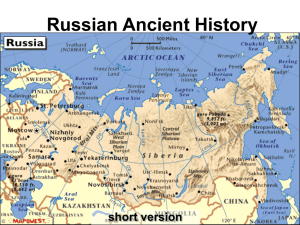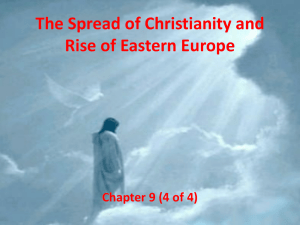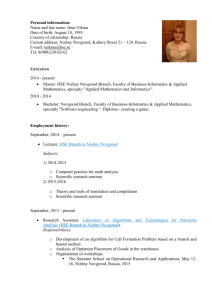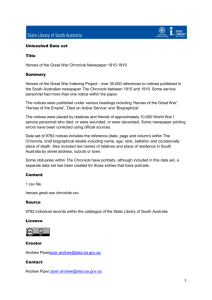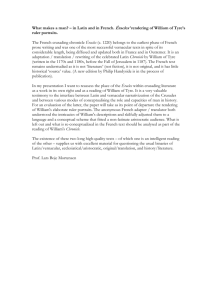Wikipedia: Rurik
advertisement
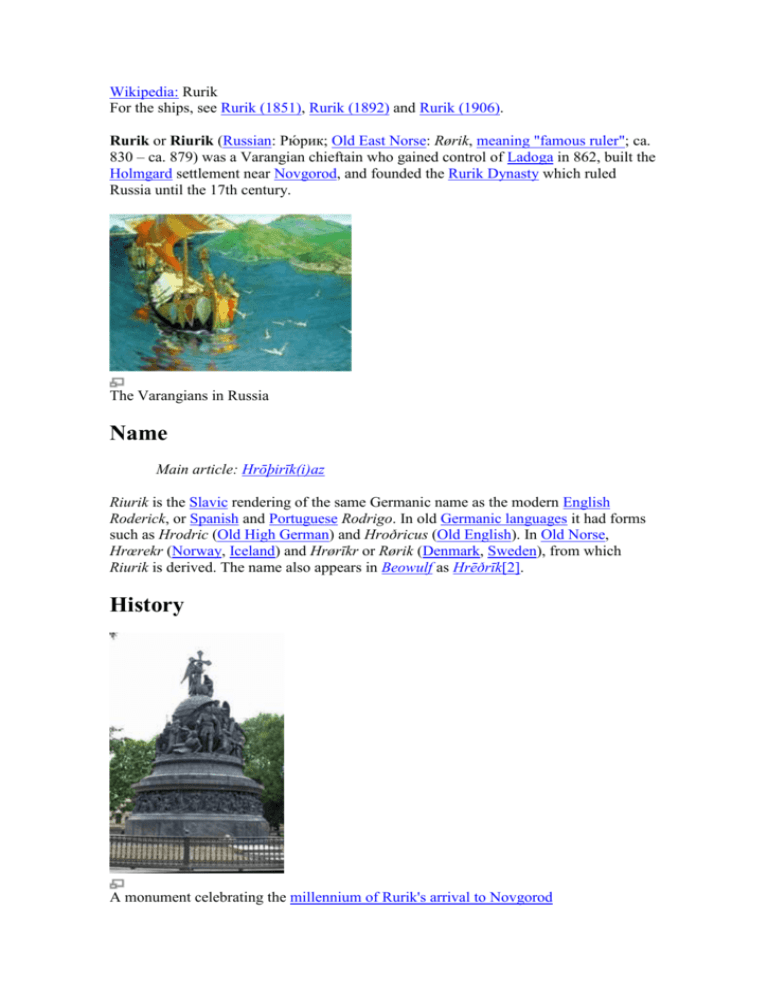
Wikipedia: Rurik For the ships, see Rurik (1851), Rurik (1892) and Rurik (1906). Rurik or Riurik (Russian: Рю́рик; Old East Norse: Rørik, meaning "famous ruler"; ca. 830 – ca. 879) was a Varangian chieftain who gained control of Ladoga in 862, built the Holmgard settlement near Novgorod, and founded the Rurik Dynasty which ruled Russia until the 17th century. The Varangians in Russia Name Main article: Hrōþirīk(i)az Riurik is the Slavic rendering of the same Germanic name as the modern English Roderick, or Spanish and Portuguese Rodrigo. In old Germanic languages it had forms such as Hrodric (Old High German) and Hroðricus (Old English). In Old Norse, Hrœrekr (Norway, Iceland) and Hrørīkr or Rørik (Denmark, Sweden), from which Riurik is derived. The name also appears in Beowulf as Hrēðrīk[2]. History A monument celebrating the millennium of Rurik's arrival to Novgorod There is a debate over how Rurik came to control Ladoga and Novgorod. The only information about him is contained in the 12th-century Russian Primary Chronicle, which states that Chuds, Slavs, Merias, Veses and Krivichs "…drove the Varangians back beyond the sea, refused to pay them tribute, and set out to govern themselves". Afterwards the tribes started fighting each other and decided to invite Rurik to reestablish order. Rurik remained in power until his death in 879. His successors (the Rurik Dynasty), however, moved the capital to Kiev and founded the state of Kievan Rus, which persisted until 1240, the time of Mongol invasion. A number of extant princely families are patrilineally descended from Rurik, although the last Rurikid to rule Russia, Vasily IV, died in 1612. There is a large 9th-century funerary barrow in Novgorod Oblast, reminiscent of the mounds at Old Uppsala. Intricately defended against looting, it remains to be excavated. The local inhabitants refer to it as Rurik's Grave. Disputed origin Even though some historians emphasize folklore roots for the Rurik legend and consequently dismiss Rurik as a legendary figure, there is a controversy about his ethnic origins in Eastern Europe. According to the Primary Chronicle Rurik was one of the Rus, a Varangian tribe likened by the chronicler to Danes, Swedes, English and Gotlanders. In the 20th century, archaeologists partly corroborated the chronicle's version of events. It was discovered that the settlement of Ladoga, whose foundation has been ascribed to Rurik, was actually established in the mid-8th century. Earthenware, household utensils, and types of buildings from the period of Rurik's foundation correspond to patterns then prevalent in Jutland. Rurik and his brothers Truvor and Sineus arrive in Ladoga Some Slavic historians argue that the account of Rurik's invitation was borrowed by a pro-Scandinavian chronicler from a hypothetical Norse document. For instance, the Primary Chronicle states that Rurik arrived to Slavic lands with two brothers, Sineus and Truvor, and sent them to rule the towns of Beloozero and Izborsk, respectively. Instead of connecting Sineus to Signjotr and Truvor to Torvald, they suggest that the chronicler read a hypothetical Scandinavian document and misinterpreted the Norse words 'sine hus' (with house) and 'tru voring' (with loyal guard) as the names of Rurik's brothers: Sineus and Truvor. There is another theory that Rurik, on account of common intermarriages between Varangians and Slavic women, was of mixed Slavic-Varangian descent. This theory is based on the information of the first modern historian of Russia, Vasily Tatishchev (a Rurikid himself), who claimed that Rurik was of Wendish extraction. He went so far as to name his mother, Umila; his maternal grandfather, Gostomysl; and a cousin, Vadim. Those who assume good faith on Tatishchev's part point out that he based his account on the lost Ioachim Chronicle. A current DNA research project by Professor Andrzej Bajor of Poland, under the auspices of the Familytree DNA Project, seeks to more accurately place Rurik within the light of history and out of the shadows of legend, while simultaneously trying to find his modern descendants. So far, only two modern Rurikid princes have agreed to take this DNA test. Their results indicate that their male line originated in Uppland province in Sweden. So far, one Swede shares 11 of the prince's markers, and he believes that his own male line goes back to the 15th century in Roslagen. The DNA results of modern Rurikid princes indicate that Rurik was of the Finno-Ugrian descent (haplogroup N). [1] Hrörek of Dorestad Main article: Rorik of Dorestad Rorik of Dorestad, as conceived by H. W. Koekkoek The only Hrörek described in Western chronicles was Rorik of Dorestad, a konung from the royal house of Hedeby. Since the 19th century, there have been attempts to identify him with the Viking prince Rurik of Russian chronicles.[2] Roerik of Dorestad was born about 810/820 to Ali Anulo, 9th King of Hedeby. Frankish chroniclers mention that he received lands in Friesland from the Emperor Louis I. This was not enough for him, and he started to plunder neighbouring lands: he took Dorestad in 850, captured Hedeby in 857 and looted Bremen in 859. The Emperor was enraged and stripped him of all his possessions in 860. After that Roerik disappears from the Western sources for a considerable period of time. And at that very moment, in 862, the Russian Rurik arrives in the Eastern Baltic, builds the fortress of Ladoga and later moves to Novgorod. Roerik of Dorestad reappeared in Frankish chronicles in 870, when his Friesland demesne was returned to him by Charles the Bald; in 882 he is already mentioned as dead. The Russian chronicle places the death of Rurik of Novgorod at 879. According to Western sources, the ruler of Friesland was converted to Christianity by the Franks. This may have parallels with the Christianization of the Rus', as reported by Patriarch Photius in 867. Pop culture references Prince Rurik, an integral character from the game Guild Wars, was named after Rurik of Dorestad. References 1. ^ Information about his Rurikid DNA Project can be found at: [1]. Professor Bajor can be contacted at: [bajor@itme.edu.pl]. 2. ^ Rurik's identification with Hrörek was propagated by Boris Rybakov and Anatoly Kirpichnikov (see А.Н. Кирпичников: Сказание о призвании варягов. Анализ и возможности источника // Первые скандинавские чтения. - СПб., 1997. - С. 7-18). Alexander Nazarenko objects to this identification (see Nazarenko A., Rjurik и Riis Th., Rorik // Lexikon des Mittelalters. VII. - Munchen, 1995. - P. 880, 1026.) This entry is from Wikipedia, the leading user-contributed encyclopedia. It may not have been reviewed by professional editors (see full disclaimer)
